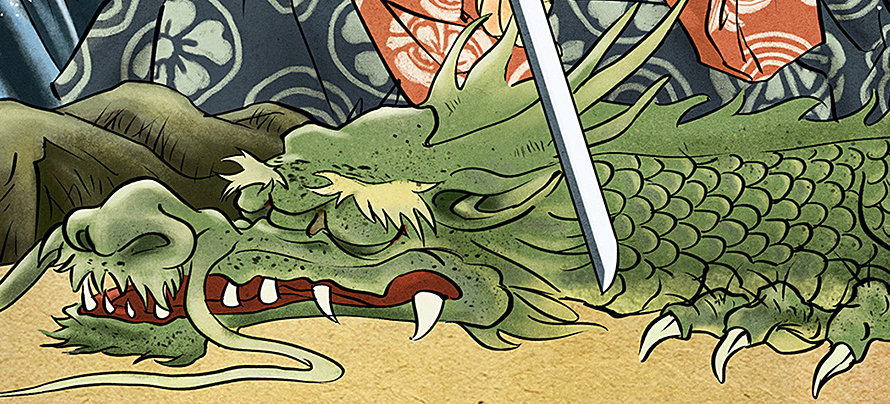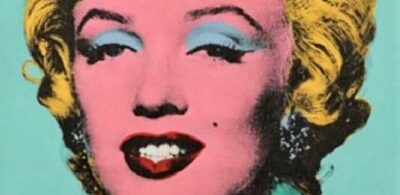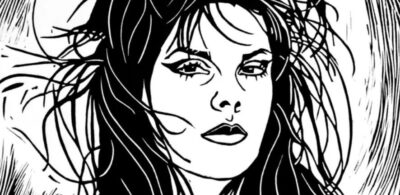Shinzo Abe RIP
Regarding the ghastly assassination of Former Japanese Prime Minister Shinzo Abe (1954-2022). I found the illustration for this essay in a far corner of the internet. Created by New Zealand based illustrator Joseph Qiu, it’s an artwork created in the style of a traditional Japanese woodcut.
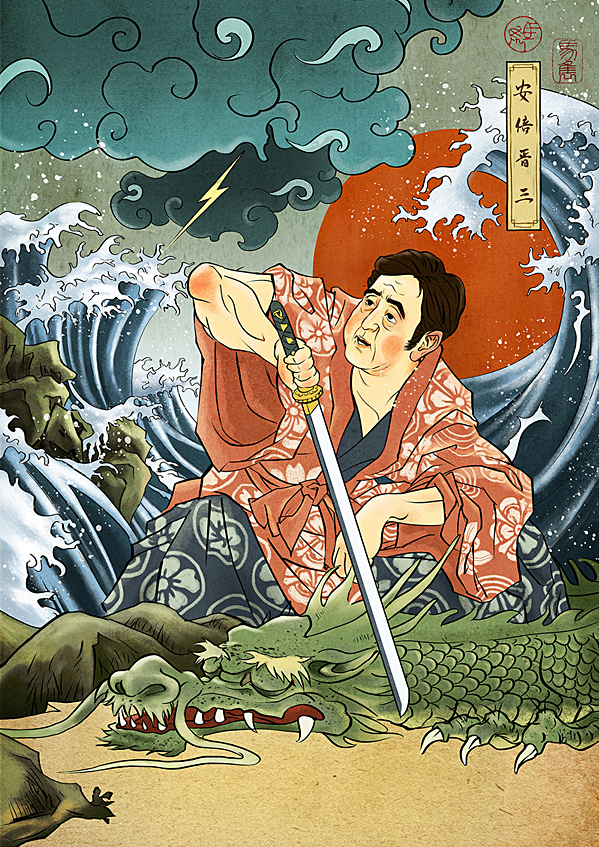
The red-sun in the background alludes to Abe’s brand of Japanese nationalism, the crashing ocean waves are evocative of works by artist Katsushika Hokusai (1760-1849), while the dragon, a common motif in Japanese art, references the Chinese Communist Party. Holding a deadly katana, Abe is depicted as a victorious Samurai warrior who has tamed the beast. Qiu rendered his faux woodblock print with the digital applications Procreate and Photoshop. On his Instagram account he said he wasn’t a fan of Shinzo Abe, but was “sorry for what happened to him and his family,” noting that he wished “the world could be a better place.”
I have always been infatuated with traditional ukiyo-e (“pictures of the floating world”), those woodblock prints created by Japanese master artists of mid-18th century Edo (now Tokyo). I wasn’t the first artist to note the aesthetics of ukiyo-e. At a very early age I discovered that great European artists like Vincent van Gogh, Paul Gauguin, Edouard Manet, Henri de Toulouse-Lautrec, Edgar Degas, and Mary Cassatt also shared my passion for the bold and colorful woodblock prints.
As I grew older I studied master artists like Kitagawa Utamaro (1753-1806), who gave the world stunning portraits of beautiful women—and Utagawa Hiroshige (1797-1858), who gifted us with observant looks at landscapes and everyday life in old Japan. Then there was the aforementioned Hokusai, best known for his tour-de-force print series Thirty-Six Views of Mount Fuji.
My favorite ukiyo-e master was Tsukioka Yoshitoshi (1839-1892). He worked in Japan as Westernization began when an American naval officer named Matthew Perry landed US ships in Tokyo harbor in 1853. Yoshitoshi was an artist that depicted the ugly realities of his day with the same attention he gave things beautiful. He created incredible prints of war scenes, showing feudal armies fighting with swords and spears along with bows and arrows; these were savage portrayals of combat. He produced a print series titled Twenty-eight Infamous Murders with Accompanying Verse, that presented abhorrent, pitiless crimes committed by people from all sectors of Japan’s 18th century society. These daunting works were replete with decapitations, cruel torture, and blood splattered kimono.
The artist was also interested in ghost stories (kaidan), and he produced the ethereal, bone-chilling woodblock series, Thirty-Six Ghosts. Yoshitoshi had the most influence on me since he portrayed real life—no matter how unpleasant, with a courageous stoic realism; he turned heartbreaking matters into exquisite and profound works of art. In small part I credit him for my embrace of social realism in art. Which brings us to the matter at hand, the monstrous assassination of Shinzo Abe.
Abe was shot in broad daylight on July 8, 2022 while giving a campaign speech in Nara City supporting candidates of his Liberal Democratic Party (LDP), this was just before the scheduled elections of July 10, 2022. The assassin used a crude double-barreled “shotgun” made of two short lengths of pipe, fixed to a wood plank with black adhesive tape, and fitted with a battery powered firing system. At the time of this writing it’s not known if the killer concocted his own explosive charges or somehow managed to acquire shotgun shells in a country where any interaction with guns is illegal. The assassin fired two shots, one missed but the second felled Abe. He died in the hospital that same day.
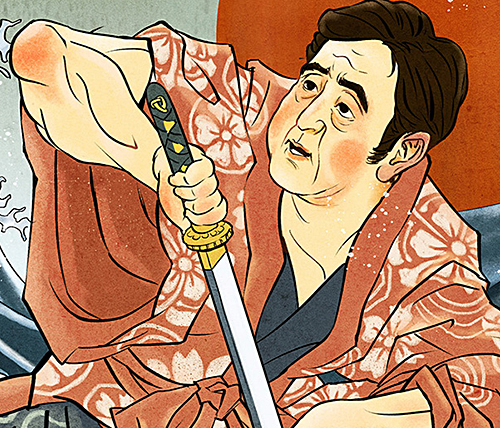
Not much has been reported about the 41-year-old assassin, but I don’t expect to hear the truth anytime soon. Abe had many enemies. He considered the Chinese Communist Party to be a serious adversary and he repeatedly defended Taiwan as an independent nation, sovereign, democratic, and free—Abe strengthened Japan’s military, infuriating both Communist China and Japan’s left. He created a solid working relationship with former President Trump—leaving American liberals apoplectic. Liberal National Public Radio (NPR) in reporting on Abe’s murder, referred to him in a tweet as a “divisive arch-conservative,” which interestingly enough was the stance of the Chinese Communist Party. Because of the massive negative online feedback by stunned Japanese and American citizens alike, NPR deleted their tweet.
Former President Trump immediately offered condolences to the family of Shinzo Abe; Trump actually issued two heartfelt statements regarding Abe’s death. This was followed by condolences from world leaders. *President Biden was belated in offering condolences; don’t think the Japanese didn’t notice. In his message Biden said: “While there are many details that we do no yet know, we know that violent attacks are never acceptable and that gun violence always leaves a deep scar on the communities that are affected by it.” Except there is no “gun violence” crisis in Japan. According to the National Police Agency of Japan in 2021 there was a single gun-related death in Japan. Again, don’t think the Japanese didn’t notice Biden’s bewildering remark, which was really aimed at American liberals.
On July 10, 2022 Japan’s voters gave a sweeping two-thirds supermajority in Japan’s parliamentary elections to the Liberal Democratic Party of former Prime Minister Shinzo Abe and current Prime Minister Kishida Fumio. The win clears the way for the LDP to amend Japan’s pacifist constitution, which forbids the nation from having armed forces that can operate overseas, and bans the “use of force as a means of settling international disputes.” With Communist China making its muscle felt in the Indo-Pacific region, it seems most Japanese are feeling nervous about not having a modern army, air force and navy.
The murder of Shinzo Abe was more than an attack on Japanese democracy, it was another indication of civilization sliding into chaos and war. Abe’s killing was a huge shock to the people of Japan, and its repercussions will be felt globally. On the night of Abe’s killing, Chinese on the controlled social media of Communist China celebrated his death, calling the assassin a “hero.” Japanese twitter was full of grieving messages comparing Abe to John F. Kennedy, the US President killed by an assassin in Dallas, Texas on Nov. 22, 1963. I watched the TV news coverage of JKF’s murder in real time in ‘63 as a 10-year-old. His slaying marked the start of a violent age—I’m getting an unpleasant sense of déjà vu.
If you have never heard of “Duck and Cover,” don’t worry, it’s back. On July 11, 2022, officials of the New York City Emergency Management Department launched a public service video recommending what “important steps” people should take in the event of a nuclear attack. The advice sounded as if officials expected only minor structural damage and a few burned trees. At the end of the message the video’s young black female presenter said: “All right, you’ve got this.” Oh yeah, sure… we’ve got this. Nuclear War? There goes my career! I’ve got news for you, if a Russian Sarmat hypersonic missile with its 10 or more atomic warheads ever slammed into the Big Apple, New York and the entire US East Coast would be obliterated. Communist China is presently working on its own hypersonic atomic missiles.
The present is beginning to look a lot like the past. The tired old adage attributed to Mark Twain is applicable here: “History doesn’t repeat itself but it often rhymes.” That notwithstanding, the free verse of today’s poetries are like marching boots and thundering missiles blotting out blackened skies. Take another look at Joseph Qiu’s artwork of Shinzo Abe as Samurai warrior. The dark clouds are ominous, lightning streaks the grayish heavens. The sea is stormy and hazardous.
But that dragon… is it slain or merely sleeping?
